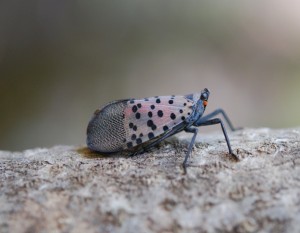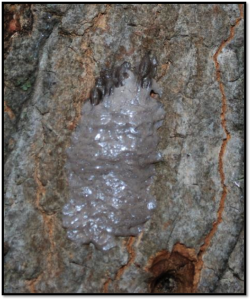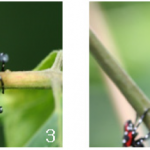Spotted lanternfly, aka Lycorma delicatula — put it on your radar now. True, as far as we know it’s not in New York. Yet. And with winter blowing in, any likelihood of seeing it this year is grows smaller by the day. But considering the havoc this new invasive could wreak if it breaks through the quarantine in Berks County, Pennsylvania, this is one pest to remember. And — especially if you’ve been in southeastern Pennsylvania of late — you can take action now.

Photo credit: L. Barringer, PA Dept of Agriculture.
This pest lays egg masses — beginning in September and up till the onset of winter — on just about anything with a smooth surface. So check your truck or camper, or any smooth-surfaced outdoor furniture or equipment you picked up during your travels. Here’s what to look for: a grey, puttylike, waxy coating over a mass of seedlike eggs that look as if they’re trying to poke through it.
What’s at risk? Apples. Grapes. Peaches. Dogwoods. Lilacs. All told, this natty but nasty critter (adults and nymphs alike are handsome little devils) hammers 70-plus species of smooth-barked trees and shrubs — plants we rely on for everything from apple pie and fine wine to the beauty they bring our yards and landscapes. And right now, our eyes are the best IPM tool we have for keeping this pest at bay.

Actually, spotted lanternfly isn’t a fly. Not even a moth, though with wings spread it sure looks like one. It’s what entomologists call a “true bug” — an insect that pierces a plant with specially adapted mouthparts that suck up sap, rather as we might drink soda with a straw. But that sap is a plant’s lifeblood. Get enough sap-sucking bugs on your grapevines or cherry trees, and you’ve got a problem on your hands.
True, lanternfly gets around by hopping and seems not to move quickly on its own, despite the adults’ pretty wings. Problem is, this adaptable pest can hitchhike unseen on just about anything — not just on trucks cars and campers but flowerpots or outdoor furniture. Suddenly, Berks County doesn’t seem so far away.
New York’s orchards and vineyards alone contribute about $330 million to the state’s economy. When you factor in the value fine wines and grape juice, peaches and cherries, landscape and forest trees and shrubs, it looks lots worse. So of course we’ll remind you about spotted lanternfly next spring.
If you think you found egg masses, take a photo, scrape some off, place your sample in alcohol or hand sanitizer in a leak proof container and report to the New York State Department of Agriculture and Markets, Division of Plant Industry at 518-457-2087 or via email at plants@agriculture.ny.gov. Think you’ve seen the bug itself? Do the same photo-hand sanitizer-report-it thing. Now.

